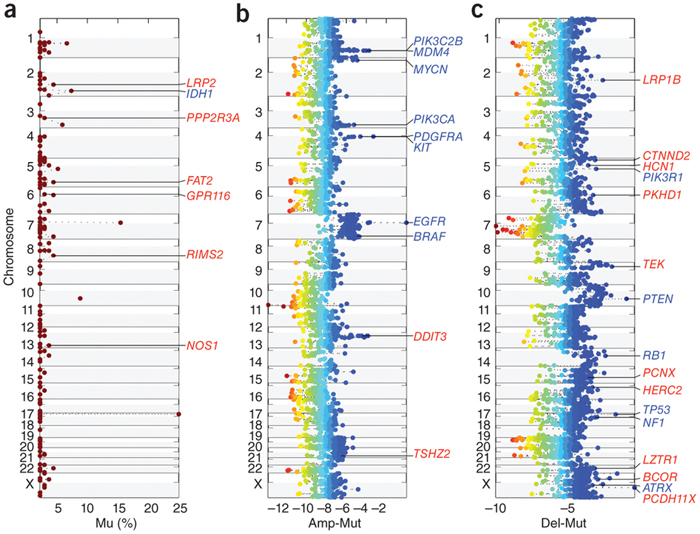News
Study Reveals Genes That Drive Glioblastoma

An analysis of all gene mutations in nearly 140 brain tumors has uncovered most of the genes responsible for driving glioblastoma. The analysis found 18 new driver genes (labeled red), never before implicated in glioblastoma and correctly identified the 15 previously known driver genes (labeled blue). The graphs show mutated genes that are commonly found in varying numbers in glioblastoma (left), that frequently contain insertions (middle), and that frequently contain deletions (right). Genes represented by blue dots in the graphs were statistically most likely to be driver genes.
A team of Columbia University Medical Center researchers has identified 18 new genes responsible for driving glioblastoma multiforme, the most common—and most aggressive—form of brain cancer in adults. The study was published August 5, 2013, in the journal Nature Genetics.
The Columbia team used a combination of high-throughput DNA sequencing and a new method of statistical analysis developed by co-author Raul Rabadan, an assistant professor in the Department of Systems Biology, to generate a short list of candidate gene mutations that were highly likely to drive cancer, as opposed to mutations that have no effect.
Considering these results along with a previous study this group conducted, Rabadan and collaborators Antonio Iavarone and Anna Lasorella point out that approximately 15% of glioblastomas could now be targeted with drugs that have already been approved by the FDA. As Lasorella remarks in an article for the CUMC Newsroom, “There is no reason why these patients couldn’t receive these drugs now in clinical trials.”
The massive study of nearly 140 brain tumors sequenced the DNA and RNA of every gene in the tumors to identify all of the mutations in each tumor. Rabadan’s algorithm was then used to identify the mutations most likely to be driver mutations. The algorithm differs from other techniques to distinguish drivers from other mutations in that it considers not only how often the gene is mutated in different tumors, but also the manner in which it is mutated.
“If one copy of the gene in a tumor is mutated at a single point and the second copy is mutated in a different way, there’s a higher probability that the gene is a driver,” Dr. Iavarone said.
The analysis identified 15 driver genes that had been previously identified in other studies—confirming the accuracy of the technique—and 18 new driver genes that had never been implicated in glioblastoma.
Once the Rabadan group’s analysis identified these driver genes, laboratory studies were done to validate their predictions. Cancer stem cells were taken from human tumors and then examined in cell culture, and after they had been implanted in mice. These studies confirmed that some of the most important candidates among the 18 new genes, such as LZTR1 and delta catenin, were driver genes in these tumors.
— Chris Williams